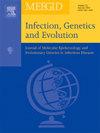埃及南部骆驼、牛、水牛及其相关蜱中支原体物种的首次检测和分子表征
IF 2.6
4区 医学
Q3 INFECTIOUS DISEASES
引用次数: 0
摘要
支原体是一种无壁细菌,可感染多种哺乳动物目,包括牲畜,并与经济上重要的疾病有关。在埃及,尽管支原体对牲畜健康和生产力有潜在影响,但关于支原体在骆驼、牛、水牛及其相关蜱中存在和多样性的分子数据仍然有限。本研究旨在检测和遗传表征埃及南部牛、水牛、骆驼及其相关蜱的支原体。对571份样本(蜱384份、水牛50份、牛68份、骆驼69份)进行了16S rRNA基因PCR筛选,并对代表性扩增子进行了系统发育分析。采集到的蜱种为单眼透明蝇、边缘透明蝇和环鼻头蜱。总体而言,在10.3%的样本中检测到支原体DNA。在2.9%的骆驼血、9.4%的骆驼血、75%的边缘骆驼血和13.8%的环纹蜱血中检出卵样支原体。在0.4%的单峰疟原虫中发现了血红支原体,在13.2%的牛和4%的水牛血液中发现了文氏支原体样。值得注意的是,这是全球首次在骆驼血液中检测到羊支原体,以及在骆驼身上传播的蜱虫中检测到羊支原体样和血支原体。本研究还报道了在埃及首次在牛中检测到文氏支原体样菌,并记录了在三种寄生于牛的蜱类中发现了卵形支原体样菌。蜱和家畜支原体序列的遗传相似性表明,这些节肢动物可能是潜在的媒介。这些发现突出了对埃及支原体的人畜共患潜力、传染性和媒介能力进行进一步研究的必要性。本文章由计算机程序翻译,如有差异,请以英文原文为准。

First detection and molecular characterization of Mycoplasma species in camels, cattle, buffalo, and their associated ticks from southern Egypt
Mycoplasma species are wall-less bacteria that infect multiple mammalian orders, including livestock, and are associated with economically significant diseases. In Egypt, molecular data on the presence and diversity of Mycoplasma spp. in camels, cattle, buffalo, and their associated ticks remain limited, despite their potential impact on livestock health and productivity. This study aimed to detect and genetically characterize Mycoplasma spp. in cattle, buffalo, camels, and their associated ticks in southern Egypt. A total of 571 samples (384 ticks, 50 buffalo, 68 cattle, and 69 camels) were screened using PCR targeting the 16S rRNA gene, followed by phylogenetic analysis of representative amplicons. Hyalomma dromedarii, Hyalomma marginatum, and Rhipicephalus annulatus were the tick species collected. Overall, Mycoplasma DNA was detected in 10.3 % of the samples. Mycoplasma ovis-like was identified in 2.9 % of camel blood, 9.4 % of H. dromedarii, 75 % of H. marginatum, and 13.8 % of R. annulatus ticks. Candidatus Mycoplasma haematovis was found in 0.4 % of H. dromedarii, and Mycoplasma wenyonii-like in 13.2 % of cattle and 4 % of buffalo blood. Remarkably, this is the first global detection of M. ovis in camel blood, as well as the detection of M. ovis-like and Ca. M. haematovis in ticks circulating on camels. This study also reports the first detection of M. wenyonii-like in bovines in Egypt and documents M. ovis-like in three tick species parasitizing cattle. The genetic similarities of Mycoplasma sequences from ticks and livestock suggest that these arthropods may serve as potential vectors. These findings highlight the need for additional studies on the zoonotic potential, infectivity, and vector competence of Mycoplasma spp. in Egypt.
求助全文
通过发布文献求助,成功后即可免费获取论文全文。
去求助
来源期刊

Infection Genetics and Evolution
医学-传染病学
CiteScore
8.40
自引率
0.00%
发文量
215
审稿时长
82 days
期刊介绍:
(aka Journal of Molecular Epidemiology and Evolutionary Genetics of Infectious Diseases -- MEEGID)
Infectious diseases constitute one of the main challenges to medical science in the coming century. The impressive development of molecular megatechnologies and of bioinformatics have greatly increased our knowledge of the evolution, transmission and pathogenicity of infectious diseases. Research has shown that host susceptibility to many infectious diseases has a genetic basis. Furthermore, much is now known on the molecular epidemiology, evolution and virulence of pathogenic agents, as well as their resistance to drugs, vaccines, and antibiotics. Equally, research on the genetics of disease vectors has greatly improved our understanding of their systematics, has increased our capacity to identify target populations for control or intervention, and has provided detailed information on the mechanisms of insecticide resistance.
However, the genetics and evolutionary biology of hosts, pathogens and vectors have tended to develop as three separate fields of research. This artificial compartmentalisation is of concern due to our growing appreciation of the strong co-evolutionary interactions among hosts, pathogens and vectors.
Infection, Genetics and Evolution and its companion congress [MEEGID](http://www.meegidconference.com/) (for Molecular Epidemiology and Evolutionary Genetics of Infectious Diseases) are the main forum acting for the cross-fertilization between evolutionary science and biomedical research on infectious diseases.
Infection, Genetics and Evolution is the only journal that welcomes articles dealing with the genetics and evolutionary biology of hosts, pathogens and vectors, and coevolution processes among them in relation to infection and disease manifestation. All infectious models enter the scope of the journal, including pathogens of humans, animals and plants, either parasites, fungi, bacteria, viruses or prions. The journal welcomes articles dealing with genetics, population genetics, genomics, postgenomics, gene expression, evolutionary biology, population dynamics, mathematical modeling and bioinformatics. We also provide many author benefits, such as free PDFs, a liberal copyright policy, special discounts on Elsevier publications and much more. Please click here for more information on our author services .
 求助内容:
求助内容: 应助结果提醒方式:
应助结果提醒方式:


